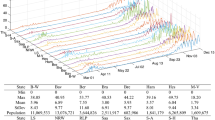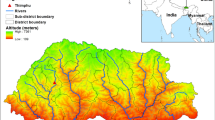Abstract
This research assesses the potential impact of weekly weather variability on the incidence of cryptosporidiosis disease using time series zero-inflated Poisson (ZIP) and classification and regression tree (CART) models. Data on weather variables, notified cryptosporidiosis cases and population size in Brisbane were supplied by the Australian Bureau of Meteorology, Queensland Department of Health, and Australian Bureau of Statistics, respectively. Both time series ZIP and CART models show a clear association between weather variables (maximum temperature, relative humidity, rainfall and wind speed) and cryptosporidiosis disease. The time series CART models indicated that, when weekly maximum temperature exceeded 31°C and relative humidity was less than 63%, the relative risk of cryptosporidiosis rose by 13.64 (expected morbidity: 39.4; 95% confidence interval: 30.9–47.9). These findings may have applications as a decision support tool in planning disease control and risk-management programs for cryptosporidiosis disease.





Similar content being viewed by others
References
Afifi A, Kotlerman J, Ettner S, Cowan M (2007) Methods for improving regression analysis for skewed continuous or counted responses. Annu Rev Public Health 28:95–111
Australian Bureau of Statistics (2002) 2001 census basic [electronic resource]. Australian Bureau of Statistics, Canberra
Australian Department of Health and Aged Care (2004) National notifiable diseases surveillance system, vol Accessed 27 May 2004: http://www1.health.gov.au/cda/Source/CDA-index.cfm
Breiman L, Fredman J, Olshen R, Stone C (1984) Classification and regression trees. Chapman & Hall (Wardworth), New York
Cameron A, Trivedi P (1998) Regression analysis of count data. Cambridge University Press, Cambridge
Chatfield C (1975) The analysis of time series: theory and practice. Chapman & Hall, London
Cheung Y (2002) Zero-inflated models for regression analysis of count data: a study of growth and development. Stat Med 21:1461–1469
Hu W, Tong S, Mengersen K, Connell D (2007) Weather variability and the incidence of cryptosporidiosis: comparison of time series Poisson regression and SARIMA models. Ann Epidemiol 17:679–688
Intergovernmental Panel on Climate Change (2007) Climate Change 2007. Cambridge University Press, Cambridge
Jacobsen B, Dannenburg D (2003) Volatility clustering in monthly stock returns. J Empir Finance 10:479–503
Lambert D (1992) Zero-inflated Poisson regression, with an application to defects in manufacturing. Technometrics 34:1–14
Long J (1997) Regression models for categorical and limited dependent variables. Sage, Thousand Oaks, CA
Makridakes S, Wheelwright S, Hyndman R (1998) Forecasting: methods and applications. Wiley, New York
McMichael A, Haines A, Kovats R, Slooff R (1996) Climate changes and human health. WHO, Geneva
Meinhardt P, Casemore D, Miller K (1996) Epidemiologic aspects of human cryptosporidiosis and the role of waterborne transmission. Epidemiol Rev 18:118–136
Petersen T, Koput K (1992) Time aggregation bias in hazard-rate models with covariates. Sociol Methods Res 21:25–51
Ridout M, Hinde J, Demétrio C (2001) A score test for testing a zero-inflated Poisson regression model against zero-inflated negative binomial alternatives. Biometrics 57:219–223
Rose J, Huffman D, Gennaccaro A (2002) Risk and control of waterborne cryptosporidiosis. FEMS Microbiol Rev 26:113–123
STATA (2005) Stata base reference manual release 9. Stata, College Station, TX
Vuong Q (1989) Likelihood tests for model selection and non-nested hypotheses. Econometrics 57:307–333
Zeger S (1988) A regression model for time series of counts. Biometrika 75:621–629
Author information
Authors and Affiliations
Corresponding author
Rights and permissions
About this article
Cite this article
Hu, W., Mengersen, K., Fu, SY. et al. The use of ZIP and CART to model cryptosporidiosis in relation to climatic variables. Int J Biometeorol 54, 433–440 (2010). https://doi.org/10.1007/s00484-009-0294-4
Received:
Revised:
Accepted:
Published:
Issue Date:
DOI: https://doi.org/10.1007/s00484-009-0294-4




